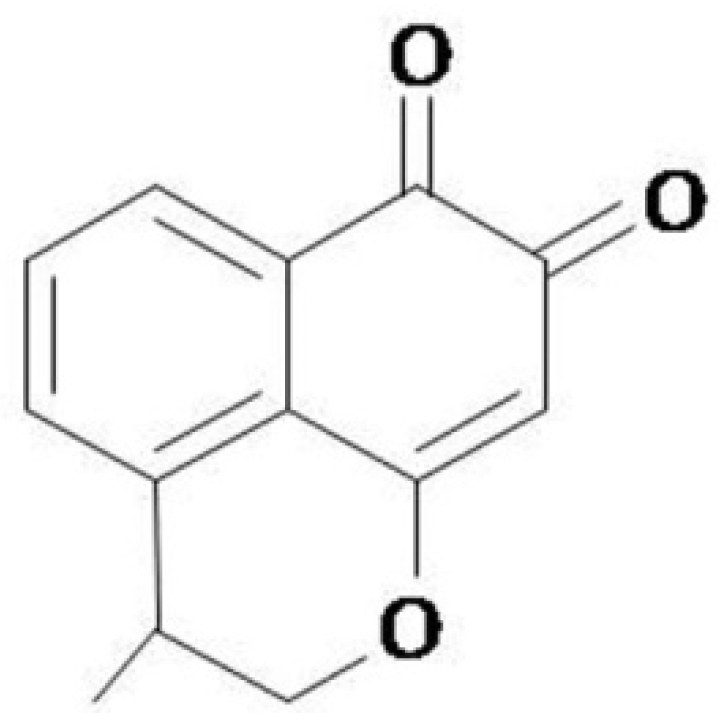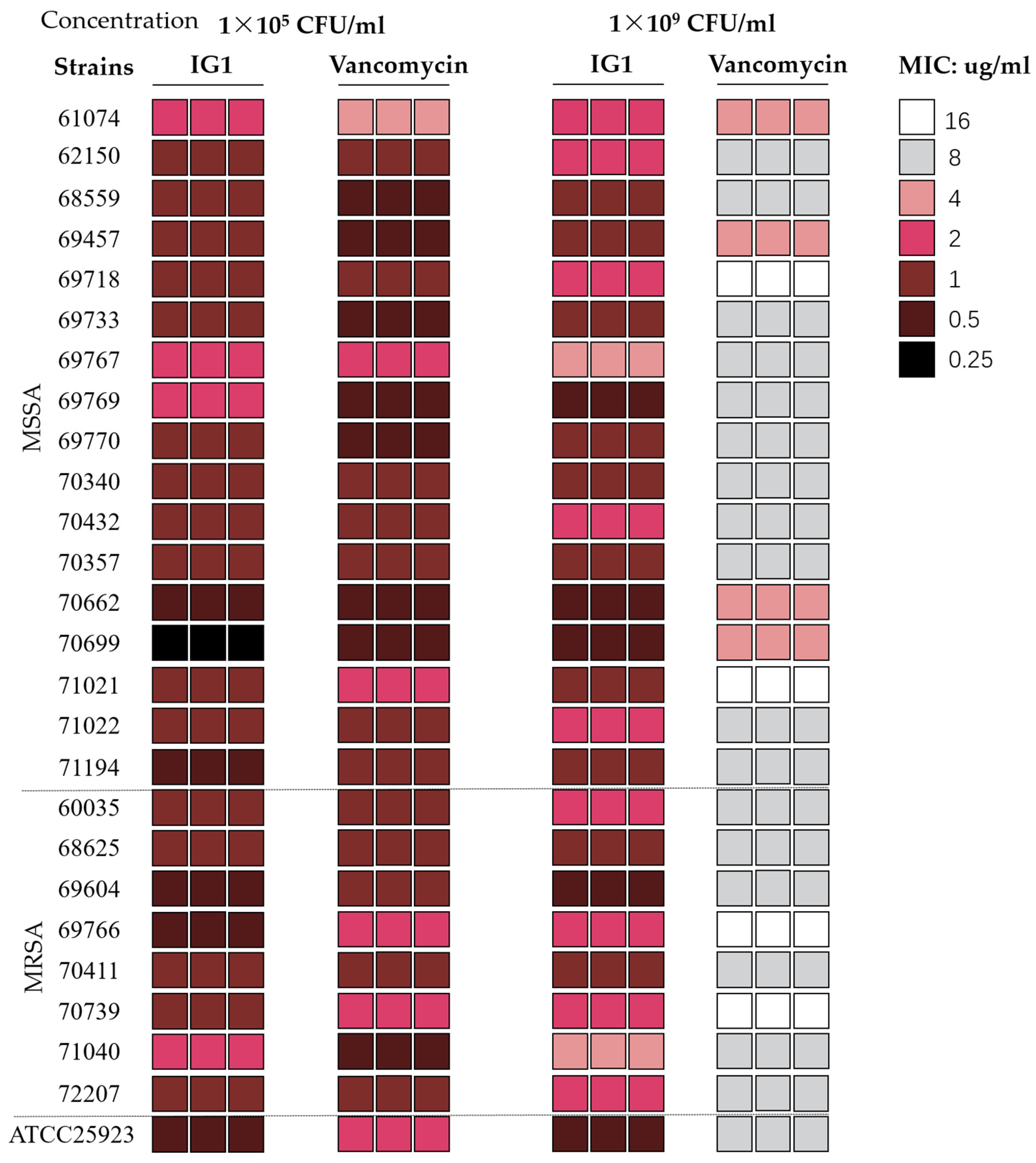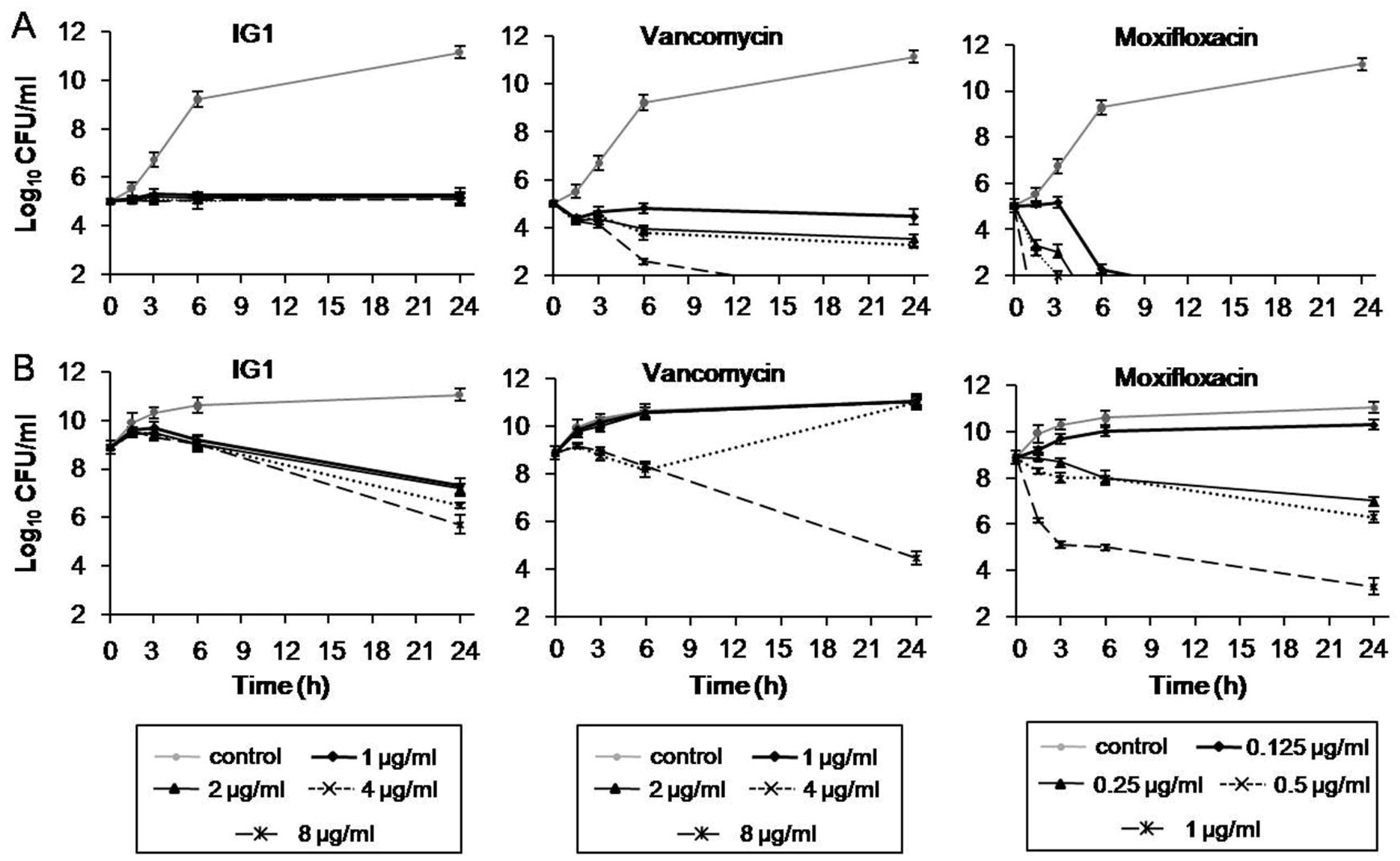IG1, a Mansonone F Analog, Exhibits Antibacterial Activity against Staphylococcus aureus by Potentially Impairing Cell Wall Synthesis and DNA Replication
Abstract
1. Introduction
2. Materials and Methods
2.1. Regents
2.2. Bacterial Identification and Culture
2.3. Antimicrobial Susceptibility Testing
2.4. Transmission Electron Microscopy Assay
2.5. Time–Kill Assays
2.6. Measurement of DNA Content
2.7. Statistical Analysis
3. Results
3.1. Antibacterial Activity of IG1 on S. aureus
3.2. Time–Kill Kinetics of IG1
3.3. Effect of IG1 on DNA Content and Cell Division of S. aureus
3.4. Effect of IG1 on Cell Morphology of S. aureus
4. Discussion
5. Conclusions
Author Contributions
Funding
Institutional Review Board Statement
Informed Consent Statement
Data Availability Statement
Acknowledgments
Conflicts of Interest
References
- Guo, Y.; Song, G.; Sun, M.; Wang, J.; Wang, Y. Prevalence and Therapies of Antibiotic-Resistance in Staphylococcus aureus. Front. Cell. Infect. Microbiol. 2020, 10, 107. [Google Scholar] [CrossRef] [PubMed]
- Wang, D.; Xia, M.; Cui, Z.; Tashiro, S.; Onodera, S.; Ikejima, T. Cytotoxic effects of mansonone E and F isolated from Ulmus pumila. Biol. Pharm. Bull. 2004, 27, 1025–1030. [Google Scholar] [CrossRef] [PubMed]
- Tiew, P.; Ioset, J.R.; Kokpol, U.; Chavasiri, W.; Hostettmann, K. Antifungal, antioxidant and larvicidal activities of compounds isolated from the heartwood of Mansonia gagei. Phytother. Res. 2003, 17, 190–193. [Google Scholar] [CrossRef]
- Kim, J.P.; Kim, W.G.; Koshino, H.; Jung, J.; Yoo, I.D. Sesquiterpene O-naphthoquinones from the root bark of Ulmus davidiana. Phytochemistry 1996, 43, 425–430. [Google Scholar] [CrossRef]
- Xie, H.-T.; Zhou, D.-C.; Mai, Y.-W.; Huo, L.; Yao, P.-F.; Huang, S.-L.; Wang, H.-G.; Huang, Z.-S.; Gu, L.-Q. Construction of the oxaphenalene skeletons of mansonone F derivatives through C–H bond functionalization and their evaluation for anti-proliferative activities. RSC Adv. 2017, 7, 20919–20928. [Google Scholar] [CrossRef]
- Kali, A. Antibiotics and bioactive natural products in treatment of methicillin resistant Staphylococcus aureus: A brief review. Pharmacogn. Rev. 2015, 9, 29–34. [Google Scholar] [CrossRef]
- Hairani, R.; Mongkol, R.; Chavasiri, W. Allyl and prenyl ethers of mansonone G, new potential semisynthetic antibacterial agents. Bioorg. Med. Chem. Lett. 2016, 26, 5300–5303. [Google Scholar] [CrossRef]
- Suh, Y.G.; Kim, S.N.; Shin, D.Y.; Hyun, S.S.; Lee, D.S.; Min, K.H.; Han, S.M.; Li, F.; Choi, E.C.; Choi, S.H. The structure-activity relationships of mansonone F, a potent anti-MRSA sesquiterpenoid quinone: SAR studies on the C6 and C9 analogs. Bioorg. Med. Chem. Lett. 2006, 16, 142–145. [Google Scholar] [CrossRef]
- Shin, D.; Park, S.-H.; Park, S.; Lee, C.-Y.; Suh, Y.-G. Efficient Synthesis of 1-Thiomansonones with Anti-MRSA Activity. Synlett 2018, 29, 938–942. [Google Scholar] [CrossRef]
- Shin, D.Y.; Kim, S.N.; Chae, J.H.; Hyun, S.S.; Seo, S.Y.; Lee, Y.S.; Lee, K.O.; Kim, S.H.; Lee, Y.S.; Jeong, J.M.; et al. Syntheses and anti-MRSA activities of the C3 analogs of mansonone F, a potent anti-bacterial sesquiterpenoid: Insights into its structural requirements for anti-MRSA activity. Bioorg. Med. Chem. Lett. 2004, 14, 4519–4523. [Google Scholar] [CrossRef]
- Liu, Z.; Huang, S.L.; Li, M.M.; Huang, Z.S.; Lee, K.S.; Gu, L.Q. Inhibition of thioredoxin reductase by mansonone F analogues: Implications for anticancer activity. Chem. Biol. Interact. 2009, 177, 48–57. [Google Scholar] [CrossRef] [PubMed]
- Martineau, F.; Picard, F.J.; Roy, P.H.; Ouellette, M.; Bergeron, M.G. Species-specific and ubiquitous-DNA-based assays for rapid identification of Staphylococcus aureus. J. Clin. Microbiol. 1998, 36, 618–623. [Google Scholar] [CrossRef] [PubMed]
- Miao, J.; Chen, L.; Wang, J.; Wang, W.; Chen, D.; Li, L.; Li, B.; Deng, Y.; Xu, Z. Evaluation and application of molecular genotyping on nosocomial pathogen-methicillin-resistant Staphylococcus aureus isolates in Guangzhou representative of Southern China. Microb. Pathog. 2017, 107, 397–403. [Google Scholar] [CrossRef] [PubMed]
- James, H.; Jorgensen, J.D.T. Susceptibility test methods: Dilution and disk diffusion methods. In Manual of Clinical Microbiology, 11th ed.; James, H., Jorgensen, K.C.C., Funke, G., Pfaller, M.A., Landry, M.L., Richter, S.S., Warnock, D.W., Eds.; Wiley Online Library: Hoboken, NJ, USA, 2015. [Google Scholar]
- Clinical and Laboratory Standards Institute. Performance Standards for Antimicrobial Susceptibility Testing: Twenty-Second Informational Supplement M100-S25; CLSI: Wayne, PA, USA, 2015. [Google Scholar]
- He, X.; Yuan, F.; Lu, F.; Yin, Y.; Cao, J. Vancomycin-induced biofilm formation by methicillin-resistant Staphylococcus aureus is associated with the secretion of membrane vesicles. Microb. Pathog. 2017, 110, 225–231. [Google Scholar] [CrossRef] [PubMed]
- Zong, X.; Cao, X.; Wang, H.; Xiao, X.; Wang, Y.; Lu, Z. Cathelicidin-WA Facilitated Intestinal Fatty Acid Absorption through Enhancing PPAR-γ Dependent Barrier Function. Front. Immunol. 2019, 10, 1674. [Google Scholar] [CrossRef] [PubMed]
- National Committee for Clinical Laboratory Standards. Methods for Determining Bactericidal Activity of Antimicrobial Agents: Approved Guideline; National Committee for Clinical Laboratory Standards: Wayne, PA, USA, 1999; Volume 19. [Google Scholar]
- Wu, W.B.; Ou, J.B.; Huang, Z.H.; Chen, S.B.; Ou, T.M.; Tan, J.H.; Li, D.; Shen, L.L.; Huang, S.L.; Gu, L.Q.; et al. Synthesis and evaluation of mansonone F derivatives as topoisomerase inhibitors. Eur. J. Med. Chem. 2011, 46, 3339–3347. [Google Scholar] [CrossRef] [PubMed]
- Ibrahim, Y.M.; Abouwarda, A.M.; Nasr, T.; Omar, F.A.; Bondock, S. Antibacterial and anti-quorum sensing activities of a substituted thiazole derivative against methicillin-resistant Staphylococcus aureus and other multidrug-resistant bacteria. Microb. Pathog. 2020, 149, 104500. [Google Scholar] [CrossRef]
- Eckmann, C.; Dryden, M. Treatment of complicated skin and soft-tissue infections caused by resistant bacteria: Value of linezolid, tigecycline, daptomycin and vancomycin. Eur. J. Med. Res. 2010, 15, 554–563. [Google Scholar] [CrossRef]
- Smith, K.; Gemmell, C.G.; Lang, S. Telavancin shows superior activity to vancomycin with multidrug-resistant Staphylococcus aureus in a range of in vitro biofilm models. Eur. J. Clin. Microbiol. Infect. Dis. 2013, 32, 1327–1332. [Google Scholar] [CrossRef]
- Lichtenstein, S.J.; Wagner, R.S.; Jamison, T.; Bell, B.; Stroman, D.W. Speed of bacterial kill with a fluoroquinolone compared with nonfluoroquinolones: Clinical implications and a review of kinetics of kill studies. Adv. Ther. 2007, 24, 1098–1111. [Google Scholar] [CrossRef]
- French, G.L. Bactericidal Agents in the Treatment of MRSA Infections—The Potential Role of Daptomycin, 17 October 2006 ed. J. Antimicrob. Chemother. 2006, 58, 1107–1117. [Google Scholar] [CrossRef] [PubMed]





| Strain | Numbers | MIC (μg/mL) | |||
|---|---|---|---|---|---|
| 1 × 105 CFU/mL 1 | 1 × 109 CFU/mL | ||||
| IG1 | Vancomycin | IG1 | Vancomycin | ||
| MSSA | 17 | 0.25~2 | 0.5~2 | 0.5~4 | 4~16 |
| MRSA | 8 | 0.5~2 | 0.5~2 | 0.5~4 | 4~16 |
| ATCC 25923 | 1 | 0.5 | 2 | 0.5 | 8 |
Publisher’s Note: MDPI stays neutral with regard to jurisdictional claims in published maps and institutional affiliations. |
© 2022 by the authors. Licensee MDPI, Basel, Switzerland. This article is an open access article distributed under the terms and conditions of the Creative Commons Attribution (CC BY) license (https://creativecommons.org/licenses/by/4.0/).
Share and Cite
Chen, X.; Lin, Y.; Gao, Q.; Huang, S.; Zhang, Z.; Li, N.; Zong, X.; Guo, X. IG1, a Mansonone F Analog, Exhibits Antibacterial Activity against Staphylococcus aureus by Potentially Impairing Cell Wall Synthesis and DNA Replication. Life 2022, 12, 1902. https://doi.org/10.3390/life12111902
Chen X, Lin Y, Gao Q, Huang S, Zhang Z, Li N, Zong X, Guo X. IG1, a Mansonone F Analog, Exhibits Antibacterial Activity against Staphylococcus aureus by Potentially Impairing Cell Wall Synthesis and DNA Replication. Life. 2022; 12(11):1902. https://doi.org/10.3390/life12111902
Chicago/Turabian StyleChen, Xin, Yueqiao Lin, Qianqian Gao, Shiliang Huang, Zihua Zhang, Nan Li, Xin Zong, and Xuemin Guo. 2022. "IG1, a Mansonone F Analog, Exhibits Antibacterial Activity against Staphylococcus aureus by Potentially Impairing Cell Wall Synthesis and DNA Replication" Life 12, no. 11: 1902. https://doi.org/10.3390/life12111902
APA StyleChen, X., Lin, Y., Gao, Q., Huang, S., Zhang, Z., Li, N., Zong, X., & Guo, X. (2022). IG1, a Mansonone F Analog, Exhibits Antibacterial Activity against Staphylococcus aureus by Potentially Impairing Cell Wall Synthesis and DNA Replication. Life, 12(11), 1902. https://doi.org/10.3390/life12111902







